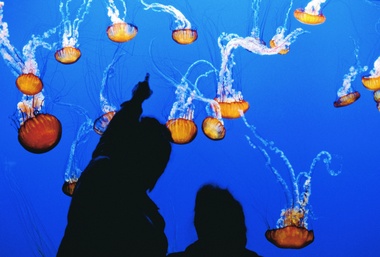For California vacationers, the Monterey Bay Aquarium is the place to see exotic fish and sea creatures. However, the Aquarium is also dedicated to educating people about environmental issues that threaten ocean creatures. And its Seafood Watch program helps the seafood-loving consumers make wise seafood choices.
Among the Monterey Bay Aquarium’s highlights are the Kelp Forest exhibit, playful sea otters, giant tunas and barracudas (go at lunchtime to witness a feeding frenzy!), and the mysterious giant octopus whose tentacles move more gracefully than ballerinas. Also worth checking out are cute black-footed penguins, jellyfish that drift in the currents, and the Touching Pool, where you can place your hands in the water and brush your fingertips over the silky wings of stingrays gliding around the tank.
These incredible marine life forms are so diverse and enthralling that it’s inconceivable to think of them disappearing. So it’s encouraging that the Aquarium teaches about ocean conservation.
Every year, 80,000 school children visit and learn about why they shouldn’t eat swordfish (the fishing lines entangle endangered sea turtles) or Atlantic cod (it’s dangerously overfished). The kids take home a handy Seafood Watch Pocket Guide, which lists the best and least sustainable choices of seafood at supermarkets and restaurants.
Watching Out for Oceans
The Monterey Bay Aquarium raises and explains issues pertaining to choosing and eating fish:
Overfishing: Fish such as orange roughy, Chilean sea bass and bluefin tuna are threatened due to over-zealous fishing. Seafood Watch estimates that more than 70 percent of the world’s fisheries are either fished to capacity or overfished.
Farmed vs. wild-caught: Some aquaculture methods, including salmon farming, produce concentrated fecal waste that pollutes surrounding waters.
Method of fishing: If fish is caught wild, methods such as trawl nets, dredging and traps kill other species. The most famous example was dolphins being caught in tuna nets.
Human health: Toxic mercury content of seafood is a disturbing health problem, although fortunately some fish contain less mercury than others. (Swordfish, tilefish, shark, and king mackerel are especially high in mercury and should be avoided.)
Fortunately, according to Seafood Watch, we can make a difference by supporting fisheries and fish farms that are better for the environment, while passing on others that aren’t doing as well.
SeafoodWatch.org has a downloadable seafood guide listing fish according to their level of endangerment. You can also download a smart phone app that brings you up-to-date recommendations for restaurants and markets that serve ocean-friendly seafood and sushi.
Cooking for Solutions
Love to eat seafood? Cooking for Solutions—a celebration of fine food and wine produced in ways that preserve the health of the soil, water and ocean—is held each May at California’s Monterey Bay Aquarium. Celebrity chefs demonstrate ways to cook sustainably.
—Laurel Kallenbach, freelance writer and editor
Read my post about Passionfish, a sustainable seafood restaurant near the Monterey Bay Aquarium.
Photos courtesy Monterey Bay Aquarium




Hi Laurel, that’s a nice post about the Aquarium, one of my favorite places (love the sea horse exhibits). And Passionfish in Pacific Grove – delish!
Thanks, Karen! And yes, the sea horses are pretty surreal! Glad to know you’ve been to Passionfish.
Great post on one of my favorite places. The Deep Ocean exhibit (think it’s called that) is amazing – I have to force myself to walk away from it. And thanks for the heads up on the Seafood Watch app, which I just downloaded. I often find myself standing at the counter wondering where I put that piece of paper!
Another concern on farmed salmon is genetic stock. British Columbian salmon farms raise Atlantic salmon, and invariably there are escapes that then interbreed with wild Pacific salmon stock. I think people often assume that farmed is better than wild, but it’s not the case.
Good point about the salmon. There are so many tricky issues with fishing—and with consuming fish. They’re tasty and mostly good for you—depending on the mercury content, but I actually try not to eat seafood too often, in hopes of curbing the depopulation of the ocean. That’s why the Seafood Watch program is so important: so that we can make wise choices about which fish to eat!
I love that place! Rose loved it when she went too, but I guess it’s been a while, because she doesn’t remember it! Time to go again! I think the jellies were my favorite last time we went.
I clearly need to go back again. Although the sea otter exhibit is temporarily closed. It’s worth the price of admission for the otters alone.
I love the Aquarium too. I took so many field trips there with my students–and then used the free teacher’s pass to return on my own.
Our family was a charter member of the Monterey Bay Aquarium and I’m so happy to know that my granddaughter has spent many happy hours there. It is a fabulous place, really extraordinary, especially for all the great education and research done there.